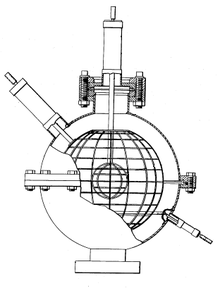Electrostatic inertial confinement
As Fusor ( English inertial electrostatic confinement , IEC) are referred to procedures that attempt a plasma high density and high energy ions alone or, preferably, by means of an electric field to be generated. IEC arrangements are built with the aim of achieving fusion reactions between atomic nuclei of hydrogen isotopes ( deuterium or deuterium and tritium ). Therefore the devices are also called Farnsworth-Hirsch-Fusor or Hirsch-Meeks-Fusor after their developers . The Polywell arrangement is a related concept.
Since neutrons are released in the hydrogen fusion reactions , the electrostatic inertial confinement could be used as the basis for a neutron source . The concept is not suitable for generating energy.
technology
The concept of electrostatic inertial confinement to achieve nuclear fusion is based on the fact that deuterium and / or tritium ions are kept in a small area by an electric field and bombarded from the outside with further, high-energy ions of the same type (s). In contrast to nuclear fusion reactors with magnetic confinement, the energy in the collision is not given by the temperature of the plasma, but rather higher ion energies can be used (by means of high acceleration voltages). As a result, the Coulomb barrier is more easily overcome during collision, so that the probability ( cross-section ) for the fusion reaction during collision increases.
A frequency of the fusion reactions which would be sufficient for a net energy production cannot be achieved with this method.
history
Early work on this technique was done by Philo Farnsworth on the basis of observations on television tubes . The original designs in the early 1960s were based on cylindrical arrangements of electrodes . The fuel for nuclear fusion, ie deuterium , was accelerated from ion sources in the direction of the inner reaction zone; Ions of the fuel should be held there by electrostatic forces. Farnsworth coined the term Inertial Electrostatic Confinement (German: 'electrostatic inertia inclusion'). However , this technique has nothing to do with inertial confinement in the sense of inertial fusion .
Major developments were made by Robert L. Hirsch . In the late 1960s he built a large device with six ion sources and a high voltage supply of up to 150 kV . With this device nearly 10 8 fusion events per second were achieved with deuterium . Hirsch also proposed a structure without an ion cannon. A high voltage is applied between two concentric spherical electrode grids, which are located in a larger container that is filled with deuterium under low pressure. The glow discharge ignited by the high voltage generates the desired deuterium ions through electron impact.
In the early 1980s it was possible to demonstrate in various experiments that in such an arrangement a potential minimum is formed within the inner, spherical grid electrode. However, closer investigations could not determine any increased ion density in this potential.
Experiments, mostly with glow discharge , but also with additional ion sources, were also carried out at other institutes, such as the Los Alamos National Laboratory and DaimlerChrysler Aerospace (1996–2000).
Individual evidence
- ^ TA Thorson, RD Durst, RJ Fonck, AC Sontag: Fusion Reactivity Characterization of a Spherically Convergent Ion Focus . In: Nuclear Fusion . Volume 38, No. 4, April 1998, p. 495 ( doi : 10.1088 / 0029-5515 / 38/4/302 ).
literature
Patents
- Patent US3258402 : Electric discharge device for producing interactions between nuclei. Published on June 28, 1966 , inventor: Philo T. Farnsworth (at that time still anode grid inside, cathode outside, electron cloud inside the anode grid acts as a virtual cathode).
- Patent US3386883 : Method and apparatus for producing nuclear-fusion reactions. Published June 4, 1968 , inventor: Philo T. Farnsworth (cathode grid inside, ion source outside).
- Patent US3530036 : Apparatus for generating fusion reactions. Published September 22, 1970 , Inventor: Robert L. Hirsch (Multiple Radial Ion Sources).
- Patent US3530497 : Apparatus for generating fusion reactions. Published September 22, 1970 , Inventors: Robert L. Hirsch, Gene A. Meeks (additional electron source near the cathode grid).
- Patent US3533910 : Lithium ion source in apparatus for generating fusion reactions. Published October 13, 1970 , Inventor: Robert L. Hirsch (Fusor with lithium ion source).
Magazine articles
- Robert L. Hirsch: Inertial-Electrostatic Confinement of Ionized Fusion Gases . In: Journal of Applied Physics . Volume 38, No. 11, October 1967, pp. 4522-4534.
- RA Anderl, JK Hartwell, JH Nadler, JM DeMora, RA Stubbers, GH Miley: Development of an IEC Neutron Source for NDE . In: GH Miley, CM Elliott (editors): 16th Symposium on Fusion Engineering . IEEE Conf. Proc. 95CH35852, IEEE Piscataway, NJ, 1482-1485 (1996).
- William C. Elmore, James L. Tuck, Kenneth M. Watson: On the Inertial-Electrostatic Confinement of a Plasma . In: The Physics of Fluids . Volume 2, No. 3, May – June 1959.
Further information
- TH Rider: A General Critique of Inertial-Electrostatic Confinement Fusion Systems . Ed .: Master's thesis at MIT . 1991 (English, A General Critique of Inertial-Electrostatic Confinement Fusion Systems ( Memento from June 30, 2007 in the Internet Archive ) [PDF; 22.1 MB ] Overview and description of the basic problems).
- RP Ashley, GL Kulcinski, JF Santarius, S. Krupakar Murali, G. Piefer :: D-3He Fusion in an Inertial Electrostatic Confinement Device . In: IEEE Publication 99CH37050 . October 1999, p. 35–37 (English, wisc.edu [PDF; 143 kB ] From the 18th Symposium on Fusion Engineering . Albuquerque, New Mexico, 25-29. October 1999).
- K. Yoshikawa et al .: Current status of inertial electrostatic confinement fusion neutron / proton source. Archived from the original on May 27, 2012 .
